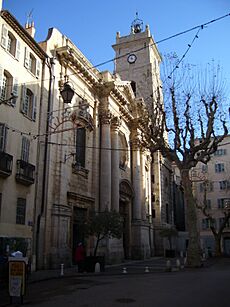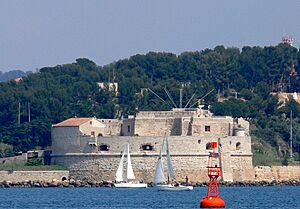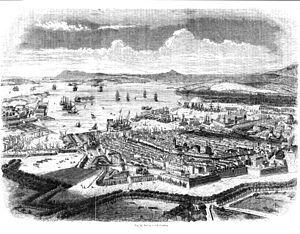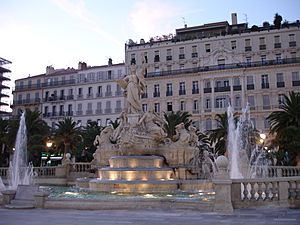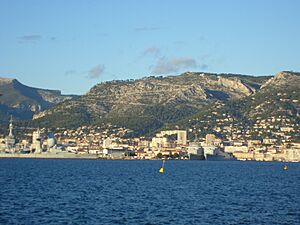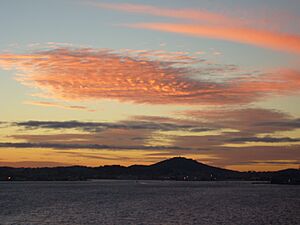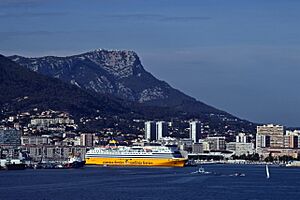Toulon facts for kids
Quick facts for kids
Toulon
Tolon (Occitan)
|
|||
|---|---|---|---|
|
Prefecture and commune
|
|||

Top left: Toulon Opera House, top right: Mayol Stadium (Le Stade du Mayol), 2nd: panoramic view of downtown Toulon and its port, 3rd left: Place de la Liberté, 3rd right: the beaches of Mourillon, bottom left: the cable car to Mount Faron, bottom right: Fort Saint-Louis
|
|||
|
|||
| Country | France | ||
| Region | Provence-Alpes-Côte d'Azur | ||
| Department | Var | ||
| Arrondissement | Toulon | ||
| Canton | Toulon-1, 2, 3 and 4 | ||
| Intercommunality | Métropole Toulon Provence Méditerranée | ||
| Area
1
|
42.84 km2 (16.54 sq mi) | ||
| Population
(2021)
|
180,452 | ||
| • Density | 4,212.2/km2 (10,909.6/sq mi) | ||
| Demonym(s) | Toulonnais | ||
| Time zone | UTC+01:00 (CET) | ||
| • Summer (DST) | UTC+02:00 (CEST) | ||
| INSEE/Postal code |
83137 /83000
|
||
| Elevation | 0–589 m (0–1,932 ft) (avg. 1 m or 3.3 ft) |
||
| 1 French Land Register data, which excludes lakes, ponds, glaciers > 1 km2 (0.386 sq mi or 247 acres) and river estuaries. | |||
Toulon is a lively city located on the French Riviera in southern France. It has a large port on the Mediterranean coast. Toulon is well-known for its important naval base. This base is home to France's aircraft carrier, the Charles de Gaulle.
Toulon is the main city of the Var department. A department is like a county or region in France. The city is part of the Provence-Alpes-Côte d'Azur region.
Around 180,000 people live in Toulon itself. This makes it one of France's largest cities. If you count the wider urban area, over 580,000 people live there. Toulon is a key place for building ships and for fishing. It also produces wine, aircraft parts, and other goods.
Contents
Toulon's Past: A Look at History
From Ancient Times to the Romans
People have lived on the coast of Provence for a very long time. This goes back to the Stone Age. Around 700 BC, Greek traders came from Asia Minor. They set up trading posts along the coast.
Later, in the 2nd century BC, the Romans arrived. They helped bring peace to the area. The Romans then started their own towns. One Roman settlement was built where Toulon is today. They called it Telo Martius.
Telo Martius became famous for making purple dye. This special color was used for royal clothes. It came from local sea snails and oak tree acorns. The harbor became a safe place for trading ships. Over time, the name Telo changed to Toulon.
Early Christianity and Counts of Provence
Toulon became a Christian city in the 400s AD. The first cathedral was built then. As the Roman Empire weakened, the city faced many attacks. Pirates and other groups often raided the area.
A Royal Port: 15th to 18th Centuries

In 1486, the region of Provence joined France. King Charles VIII of France wanted France to be a strong sea power. In 1494, he started building a military port in Toulon.
Later, in 1543, King François I made an unusual alliance. He invited the fleet of Ottoman Admiral Barbarossa to Toulon. The people of Toulon had to leave their homes. The Ottoman sailors stayed in the town for the winter.
King Louis XIV also wanted France to be a major sea power. In 1660, he ordered new defenses for Toulon. He also had a new arsenal built. An arsenal is a place where weapons are made or stored.
In 1707, during a big war, Toulon was attacked. But the city successfully defended itself. However, in 1720, a serious illness spread through the city. Many people, about half the population, died.
After the French Revolution in 1790, Toulon became a main city for the Var department. But in 1793, the city rebelled against the new government. It surrendered its fleet to the British. French forces then attacked Toulon. A young Napoleon Bonaparte was an artillery captain during this attack. The British were forced to leave. As punishment, Toulon lost its status as the department capital.
19th Century Changes
During the Napoleonic Wars, a British fleet blocked Toulon's port. This lasted from 1803 to 1805. The famous Admiral Horatio Nelson led this blockade.
In 1820, the famous Venus de Milo statue was found. A French naval officer brought it to Toulon. From there, it went to the Louvre Museum in Paris.
20th Century Events
During World War II, the German army took over southern France. French naval officers then decided to sink their own fleet in Toulon. This happened on November 27, 1942. They did this so the German army could not use the ships.
The city was bombed by the Allies in 1943. Much of the port was destroyed.
In 1979, the University of Toulon opened.
Main Places to See
Old Town Charm
Toulon's old town is the historic center. It has narrow streets and small squares. You'll find many fountains here. The Toulon Cathedral is also in this area. There's a famous market on Cours Lafayette. It sells local products every morning. The old town has been restored and now has many new shops.
Fountains of Old Toulon
The Old Town is famous for its many fountains. Each fountain has its own unique style. Most were rebuilt in the 18th or 19th century. They have all been recently restored.
Upper Town: A Modern Touch
The upper town was built in the mid-19th century. This project was started by Georges-Eugène Haussmann. He was a local leader in 1849. New buildings included the Toulon Opera and the Place de la Liberté. Haussmann later used this style to rebuild parts of Paris.
Toulon harbor is one of the best natural harbors. It is also one of the largest in Europe. A naval shipyard was built there in 1599. It was expanded by important French leaders. They wanted France to be a strong naval power.
Le Mourillon: Seaside Fun
Le Mourillon is a small seaside area. It is located east of Toulon. It used to be a fishing village. Now, it has a small fishing port. There's also a 16th-century fort called Fort Saint Louis. In the 1970s, sandy beaches were built here. These beaches are very popular today. The Museum of Asian Art is also in Mourillon.
Mount Faron: City Views
Mount Faron is a mountain that overlooks Toulon. It is 584 meters (1,916 feet) high. You can reach the top by a cable car from Toulon. There is also a narrow road. This road is used in bicycle races.
At the top of Mount Faron, there is a memorial. It honors the Allied landings in Provence in 1944. It also remembers the liberation of Toulon.
Vauban's Fortifications
Starting in 1678, Vauban built strong defenses around Toulon. Some parts were removed later to expand the city. But other parts still remain. One part you can visit is the Porte d'Italie. This was one of the old city gates. Napoleon Bonaparte started his famous Italian campaign from this gate in 1796.
Museums to Explore
Toulon has several interesting museums.
- The Museum of the French Navy is near the old port. It shows the history of Toulon as a naval port. You can see large models of 18th-century ships. There are also models of the aircraft carrier Charles De Gaulle.
- The Museum of Old Toulon and its Region has maps, paintings, and models. They all show the city's history.
- The Museum of Asian Arts is in Mourillon. It has a collection of art from India, China, and Japan. Many items were given by naval officers.
- The Museum of Art was created in 1888. It has modern and contemporary art. It also features paintings of Provence from the 17th to 20th centuries.
- The Memorial Museum to the Landings in Provence is on Mount Faron. This small museum has photos, weapons, and models. It remembers the Allied landing in Provence in 1944.
- The Museum of Natural History of Toulon and the Var has many displays. You can see dinosaurs, birds, mammals, and minerals. Most are from the local region.
- The Hôtel des arts opened in 1998. It shows art by famous modern artists.
Other Interesting Places
- Jardin d'acclimatation du Mourillon (a garden)
- Tour Royale, Toulon (a historic tower)
Toulon's Climate
Toulon has a Mediterranean climate. This means it has lots of sunshine. Summers are dry and hot. Winters are mild. Rain is rare but can sometimes be very heavy.
January is the coldest month. The average temperature is about 9.9°C (50°F). July is the warmest month. The average temperature is about 24.7°C (76°F).
Toulon gets a lot of sunshine. It averages over 2,800 hours of sun each year. This is because mountains protect Toulon from cold northern winds.
The wind is a special part of Toulon's climate. There are about 115 days a year with strong winds. These winds can be cold and dry, or wet and stormy.
| Climate data for Toulon (1991–2020 normals, extremes 1936–present) | |||||||||||||
|---|---|---|---|---|---|---|---|---|---|---|---|---|---|
| Month | Jan | Feb | Mar | Apr | May | Jun | Jul | Aug | Sep | Oct | Nov | Dec | Year |
| Record high °C (°F) | 20.9 (69.6) |
23.2 (73.8) |
26.4 (79.5) |
28.1 (82.6) |
34.7 (94.5) |
36.0 (96.8) |
40.1 (104.2) |
37.0 (98.6) |
34.9 (94.8) |
29.3 (84.7) |
24.2 (75.6) |
21.9 (71.4) |
40.1 (104.2) |
| Mean daily maximum °C (°F) | 13.2 (55.8) |
13.8 (56.8) |
16.4 (61.5) |
18.8 (65.8) |
22.6 (72.7) |
26.8 (80.2) |
29.5 (85.1) |
29.8 (85.6) |
25.9 (78.6) |
21.4 (70.5) |
16.8 (62.2) |
13.9 (57.0) |
20.7 (69.3) |
| Daily mean °C (°F) | 9.9 (49.8) |
10.1 (50.2) |
12.4 (54.3) |
14.7 (58.5) |
18.3 (64.9) |
22.2 (72.0) |
24.7 (76.5) |
25.0 (77.0) |
21.5 (70.7) |
17.8 (64.0) |
13.5 (56.3) |
10.7 (51.3) |
16.7 (62.1) |
| Mean daily minimum °C (°F) | 6.6 (43.9) |
6.3 (43.3) |
8.4 (47.1) |
10.5 (50.9) |
13.9 (57.0) |
17.5 (63.5) |
19.9 (67.8) |
20.2 (68.4) |
17.1 (62.8) |
14.1 (57.4) |
10.1 (50.2) |
7.5 (45.5) |
12.7 (54.9) |
| Record low °C (°F) | −7.2 (19.0) |
−9 (16) |
−4.3 (24.3) |
0.3 (32.5) |
4.6 (40.3) |
9.0 (48.2) |
12.8 (55.0) |
12.3 (54.1) |
8.4 (47.1) |
3.2 (37.8) |
−0.9 (30.4) |
−4.5 (23.9) |
−9 (16) |
| Average precipitation mm (inches) | 70.5 (2.78) |
46.8 (1.84) |
39.0 (1.54) |
55.4 (2.18) |
40.2 (1.58) |
27.0 (1.06) |
6.2 (0.24) |
13.4 (0.53) |
69.9 (2.75) |
105.8 (4.17) |
93.4 (3.68) |
65.8 (2.59) |
633.4 (24.94) |
| Average precipitation days (≥ 1.0 mm) | 6.0 | 5.6 | 4.8 | 6.0 | 4.3 | 2.7 | 0.9 | 1.6 | 4.5 | 6.8 | 7.9 | 6.3 | 57.5 |
| Average snowy days | 0.6 | 0.3 | 0.2 | 0.0 | 0.0 | 0.0 | 0.0 | 0.0 | 0.0 | 0.0 | 0.0 | 0.4 | 1.5 |
| Average relative humidity (%) | 59 | 58 | 55 | 55 | 56 | 53 | 50 | 50 | 56 | 59 | 60 | 60 | 55.9 |
| Mean monthly sunshine hours | 155.8 | 171.5 | 227.8 | 244.8 | 286.9 | 328.6 | 367.3 | 334.3 | 261.2 | 191.6 | 149.7 | 134.6 | 2,854.1 |
| Source 1: Meteo France | |||||||||||||
| Source 2: Meteo climat (sun 1981–2010), Infoclimat.fr (humidity and snowy days 1961–1990) | |||||||||||||
Population Growth
| Historical population | |||||||||||||||||||||||||||||||||||||||||||||||||||||||||||||||||||||||||||||||||||||||||||||||||||||||||||||||||||
|---|---|---|---|---|---|---|---|---|---|---|---|---|---|---|---|---|---|---|---|---|---|---|---|---|---|---|---|---|---|---|---|---|---|---|---|---|---|---|---|---|---|---|---|---|---|---|---|---|---|---|---|---|---|---|---|---|---|---|---|---|---|---|---|---|---|---|---|---|---|---|---|---|---|---|---|---|---|---|---|---|---|---|---|---|---|---|---|---|---|---|---|---|---|---|---|---|---|---|---|---|---|---|---|---|---|---|---|---|---|---|---|---|---|---|---|
|
|
||||||||||||||||||||||||||||||||||||||||||||||||||||||||||||||||||||||||||||||||||||||||||||||||||||||||||||||||||
| Source: EHESS and INSEE (1968–2017) | |||||||||||||||||||||||||||||||||||||||||||||||||||||||||||||||||||||||||||||||||||||||||||||||||||||||||||||||||||
Learning in Toulon
Toulon has a special school for music, theater, dance, and circus arts. It also has an art academy. The city is home to parts of the University of Toulon. A campus of KEDGE Business School is also located here.
Toulon in Books
Toulon is featured in famous books.
Victor Hugo's novel Les Misérables mentions Toulon. The main character, Jean Valjean, spends time in a prison there. This prison was called the bagne of Toulon. Part of the old prison wall still stands today.
Anthony Powell's novel What's Become of Waring also takes place in Toulon. The characters spend a summer holiday in the old town.
Joseph Conrad's last novel, The Rover, is set around Toulon.
Getting Around Toulon
Toulon has a railway station, Gare de Toulon. You can take trains to nearby cities like Marseille and Nice. There are also high-speed trains to Paris and other European cities.
The port of Toulon is a main departure point. Ferries leave from here to the island of Corsica.
The closest airport is Toulon-Hyères Airport. You can also reach the larger Marseille-Provence Airport. It offers flights to many international places.
Toulon has a public transport system called Réseau Mistral. It runs many bus routes. It also has sea shuttle lines for travel by water.
Tasty Local Food
When in Toulon, try these local foods:
- Cuisine from the Mediterranean and Provence regions.
- The cade toulonnaise, a local specialty. It's made from chickpea flour.
- The Chichi Frégi, a type of donut from Provence.
- Smash Sandwiches, a popular street food.
Sports in Toulon
Toulon is home to successful sports teams. The rugby union team RC Toulon is very popular. The women's handball team, Toulon St-Cyr Var Handball, is also top-tier. The basketball team, Hyères-Toulon Var Basket, plays in the second division.
The city hosts the final games of the Toulon Tournament. This is an international football tournament for players under 21.
Toulon's main football team is Sporting Club Toulon. Famous players like Jean Tigana and David Ginola have played for them.
| Club | Sport | League | Stadium |
|---|---|---|---|
| RC Toulon | Rugby union | Top 14 | Stade Mayol |
| Toulon St-Cyr Var Handball | Handball | Championnat de France de handball féminin | Palais des Sports |
| Hyères-Toulon Var Basket | Basketball | LNB Pro A | Palais des Sports and Espace 3000 |
| Sporting Club Toulon | Football | Championnat National | Stade de Bon Rencontre |
| Sporting Treiziste Toulonnais | Rugby league | National Division 1 | Stade Delaune |
Famous People from Toulon
Many notable people were born in Toulon, including:
- Gilbert Bécaud (1927–2001), a famous singer.
- Mireille Darc (1938–2017), an actress.
- Christophe Dominici (1972–2020), a French international rugby player.
- Félix Mayol (1972–1941), a singer and entertainer. The RC Toulon's stadium is named after him.
- Raimu (1883–1946), an actor.
- Sébastien Squillaci (born 1980), a French international footballer.
Toulon's Sister Cities
Toulon has special connections with other cities around the world. These are called sister cities:
 La Spezia, Italy (since 1958)
La Spezia, Italy (since 1958) Mannheim, Germany (since 1958)
Mannheim, Germany (since 1958) Norfolk, United States (since 1988)
Norfolk, United States (since 1988) Kronstadt, Russia (since 1996)
Kronstadt, Russia (since 1996)
See also
 In Spanish: Tolón para niños
In Spanish: Tolón para niños






